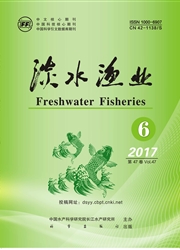

 中文摘要:
中文摘要:
对草鱼(Ctenopharyngodon idellus)先饲喂人工饲料再饲喂苏丹草,运用PCR-DGGE的方法,比较了食物改变引起的草鱼肠道微生物菌群结构的变化过程。结果显示,饲喂同种饲料的草鱼后肠与前、中肠样品间菌群结构存在显著差异(TH0-F0=-2.268,P〈0.05;TH0-M0=-2.470,P〈0.05),饲喂不同种食物的相同肠段样品间菌群结构也存在着显著差异(P〈0.05)。微生物多样性指数显示,后肠样品Shannon指数H'一般不低于4.25,而前、中肠样品H'均未超过4.25。对后肠样品进一步研究发现,食物改变11 d之后,后肠微生物菌群基本达到稳定。结果表明,草鱼肠道不同部位内容物菌群结构不同,后肠样品具有更高的微生物多样性,并且食物的改变会对草鱼肠道微生物菌群产生快速而显著的影响。
 英文摘要:
英文摘要:
PCR-DGGE fingerprinting was used to reveal the adaptation process of intestinal microbiota in Ctenopharyngodon idellus fed on artificial diet and Sudan grass .DGGE profiles of foregut , midgut and hindgut samples were compared and the results showed that the bacterial communities from hindgut contents were significant differences with those from foregut and midgut contents in C.idellus fed the same diet (TH0-F0 =-2.268, P〈0.05; TH0-M0 =-2.470, P〈0.05).Moreover, the bacterial communities of artificial feed and Sudan grass samples from the same intestinal segment (P〈0.05) also exhibited significant differences .In addition , Shannon index ( H′) of hindgut samples was almost no less than 4.25 , while H′of foregut and midgut samples was generally no more than 4.25 .The DGGE analysis of 27 hindgut samples indi-cated that intestinal microbiota reached to stabilization at 11 days later from feeding on sundan grass instead of artificial feed.In conclusion , microbiotas in different intestinal segments were different in C.idellus and food transformation also has a fast and significant influence on the composition of gut microbiota .
 同期刊论文项目
同期刊论文项目
 同项目期刊论文
同项目期刊论文
 期刊信息
期刊信息
